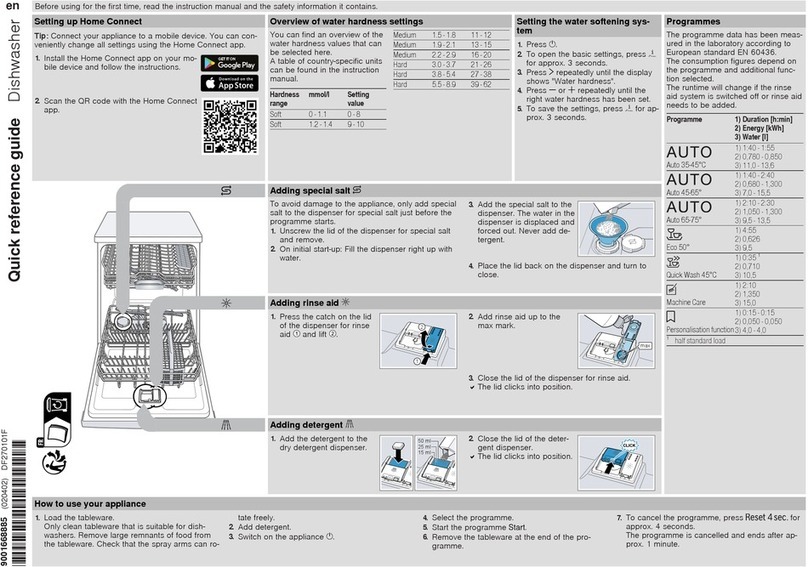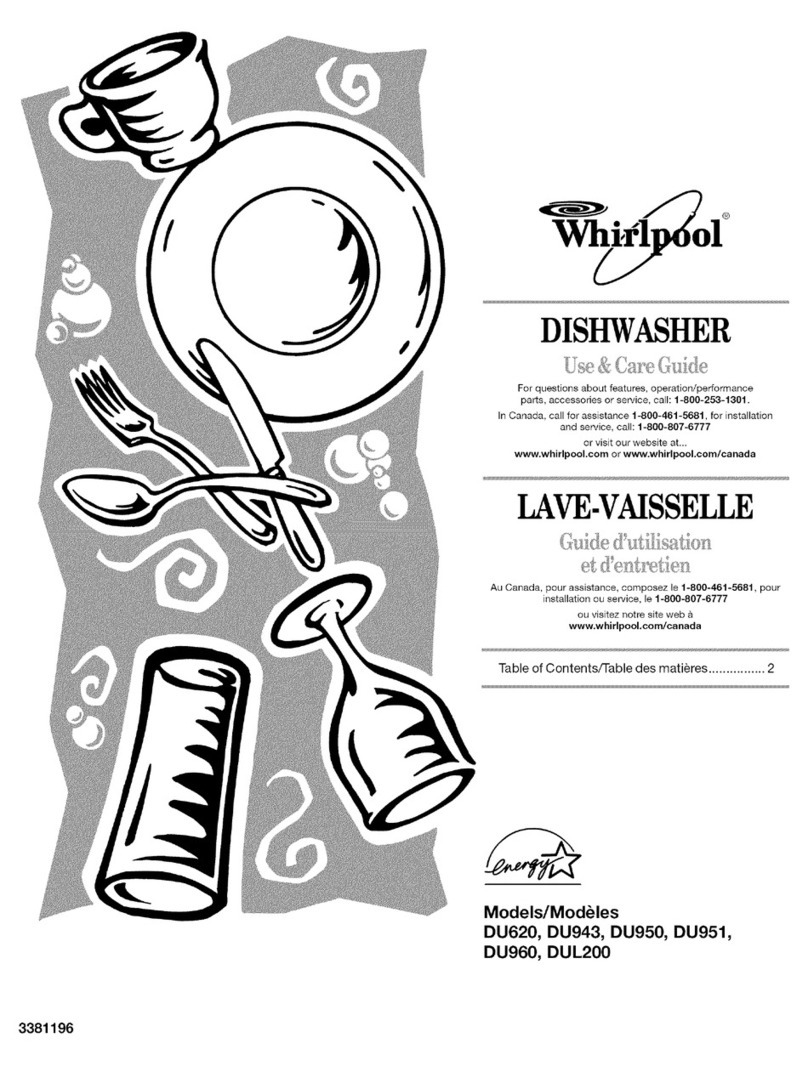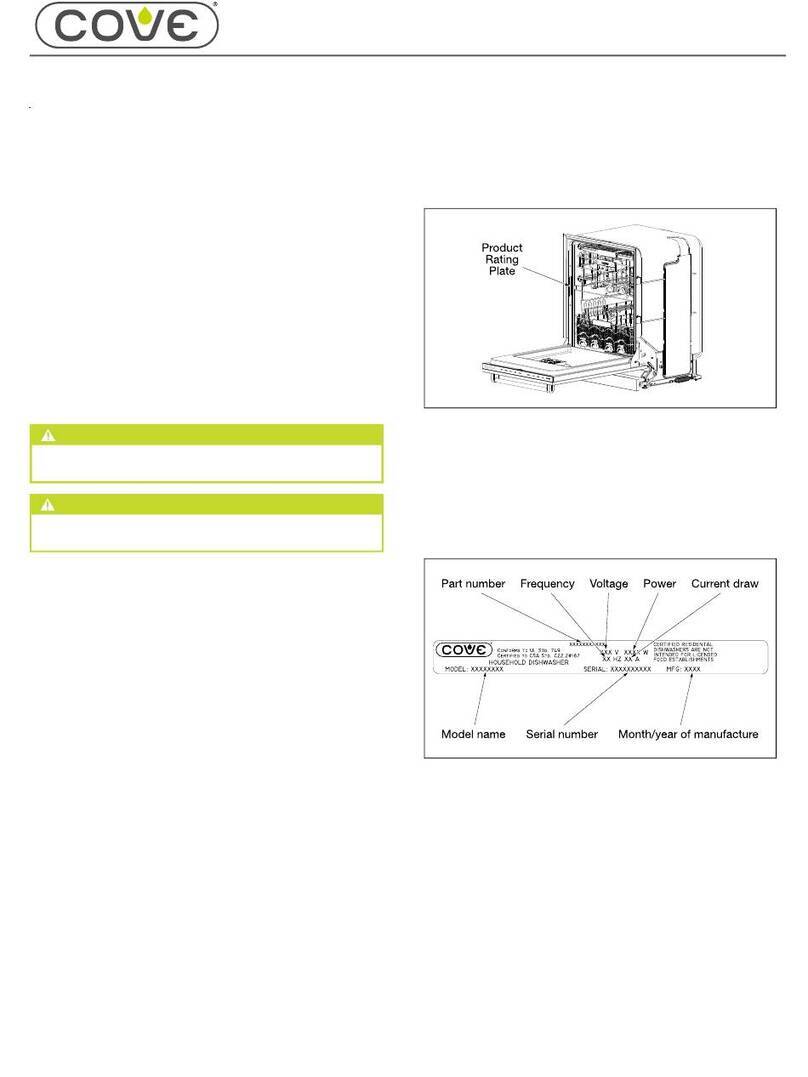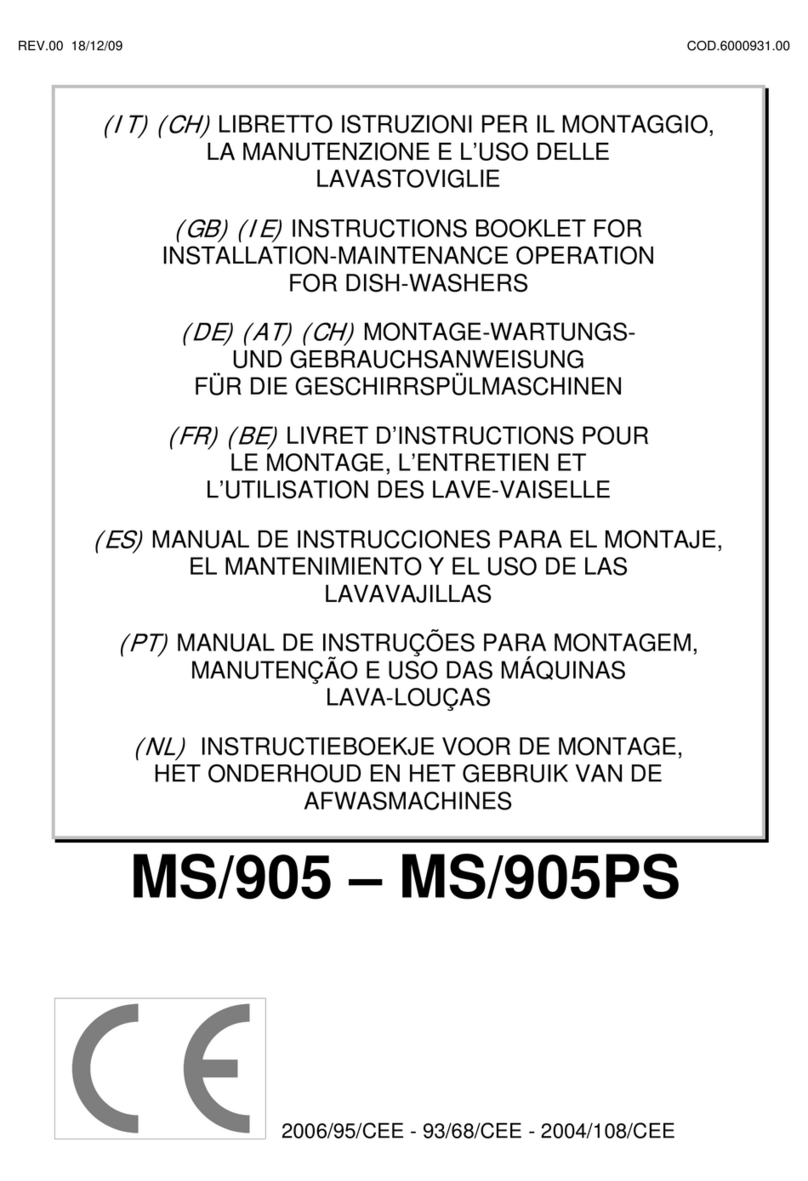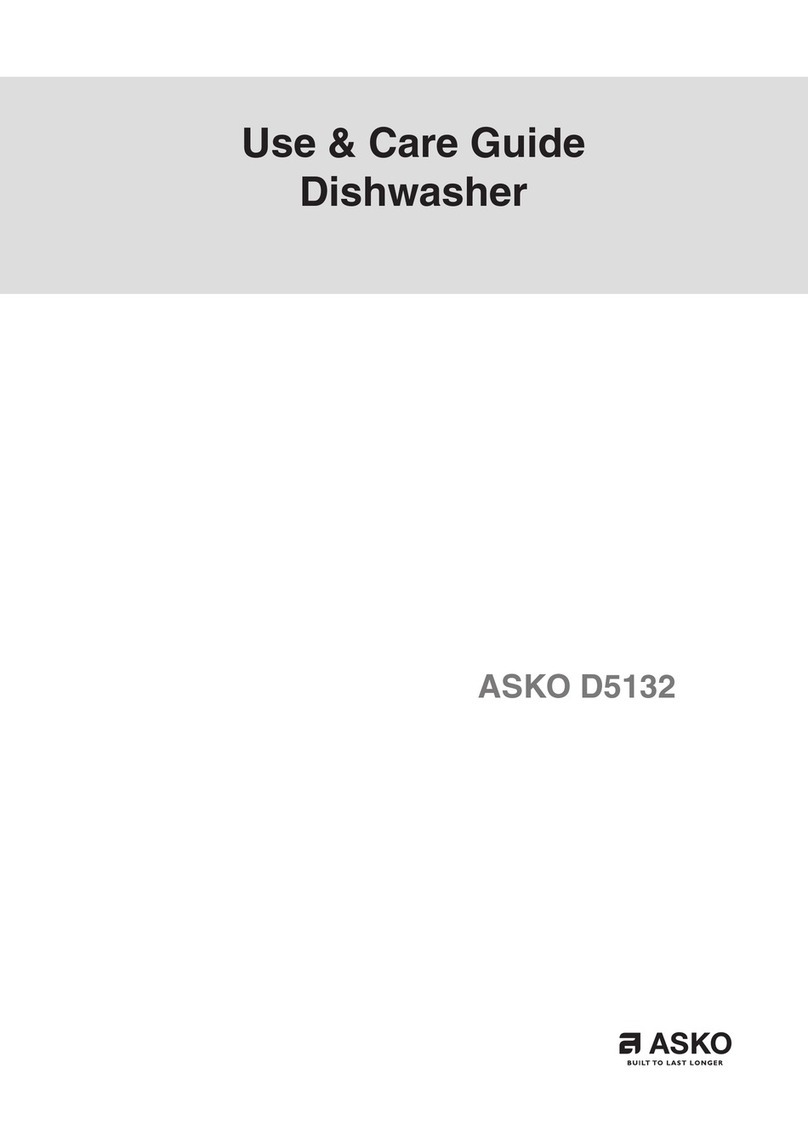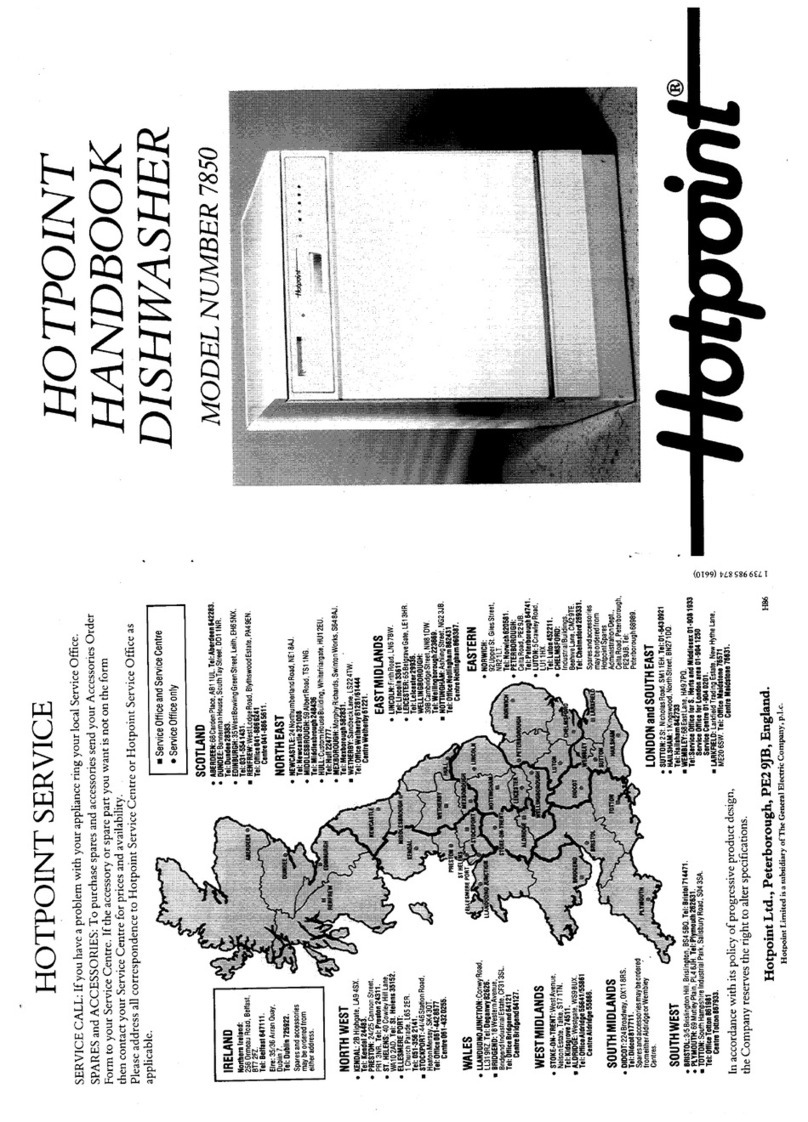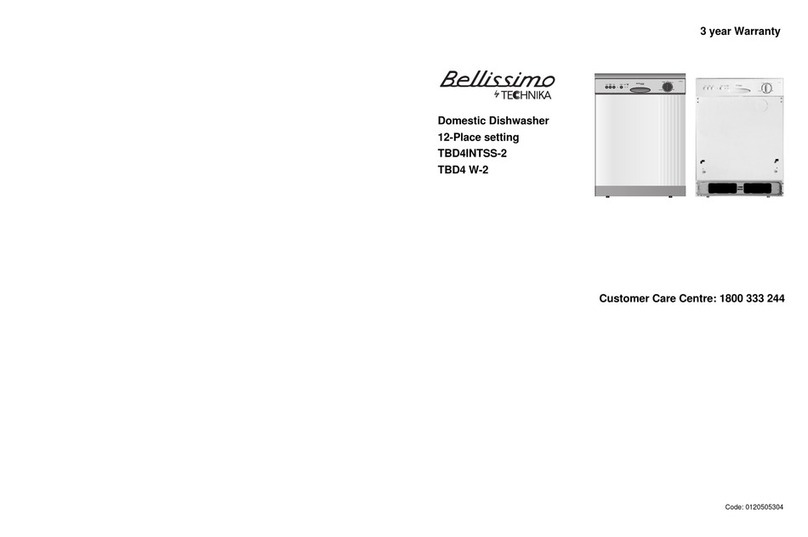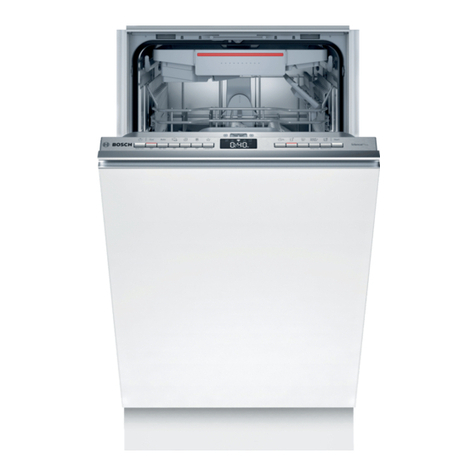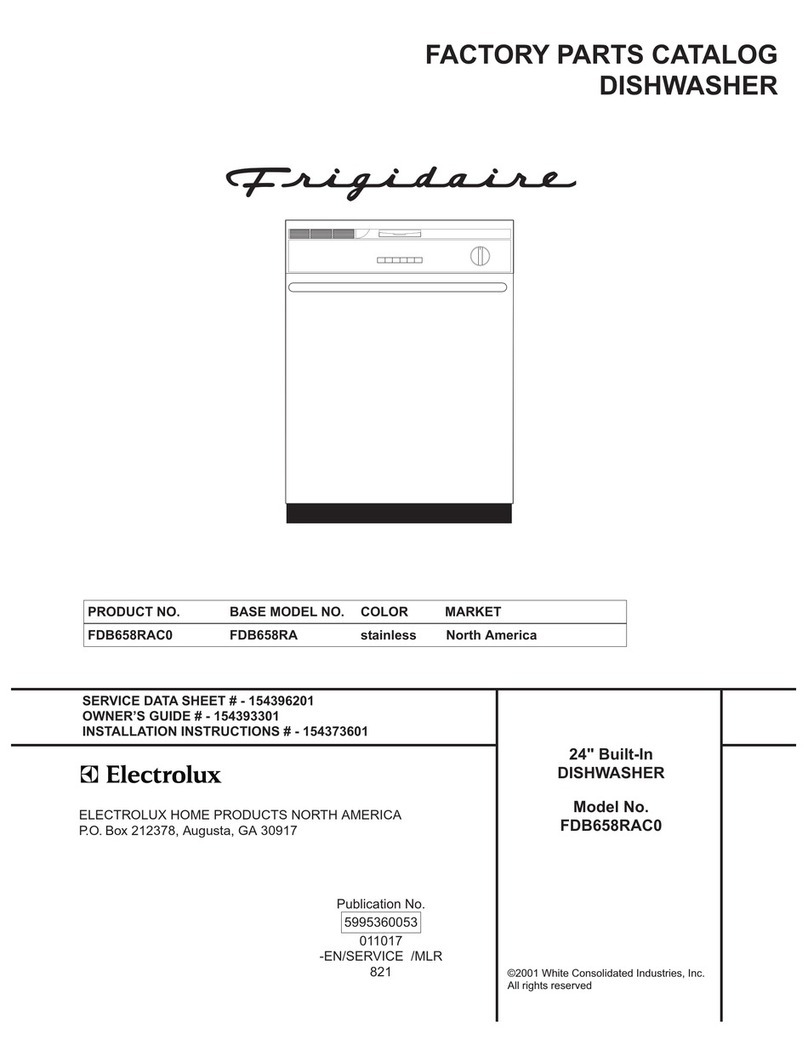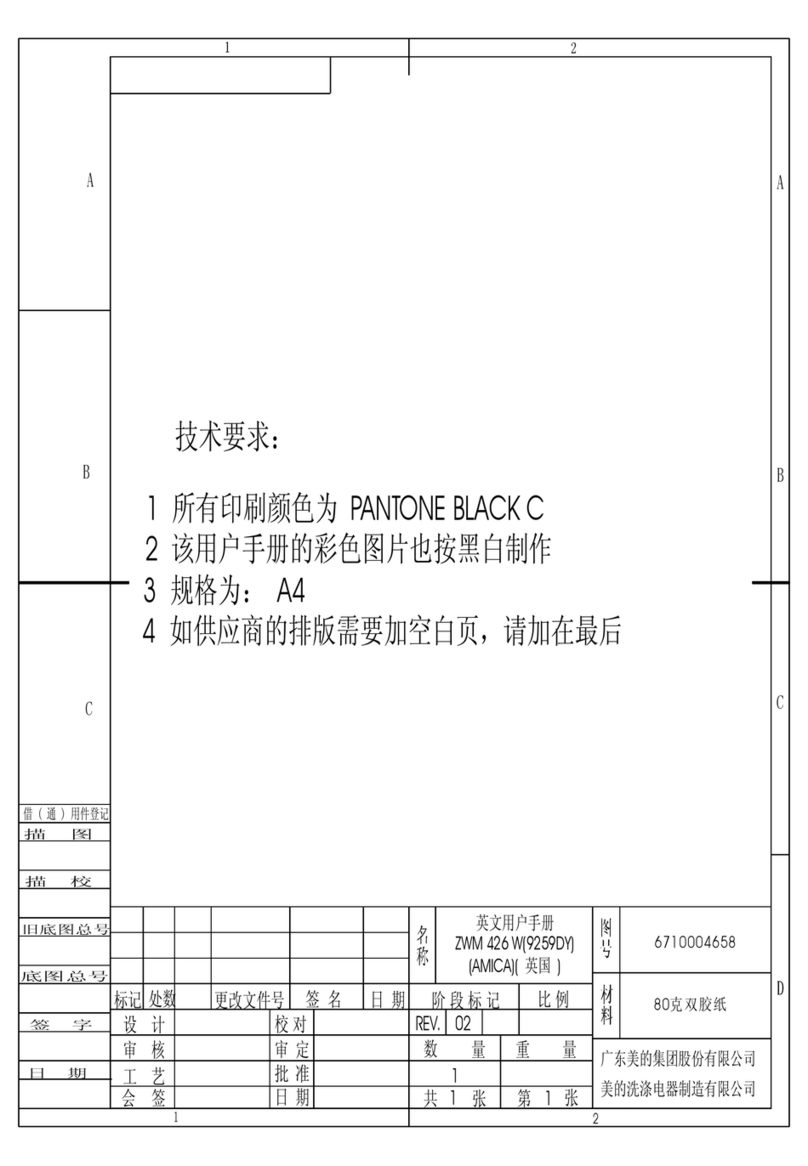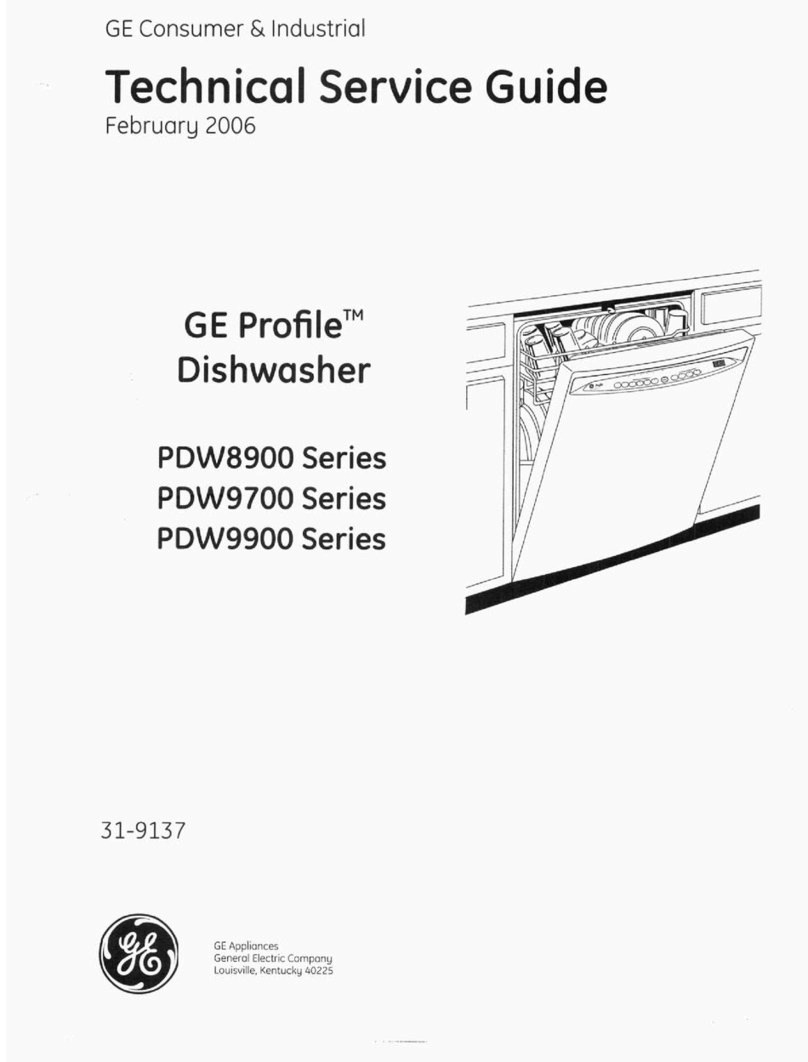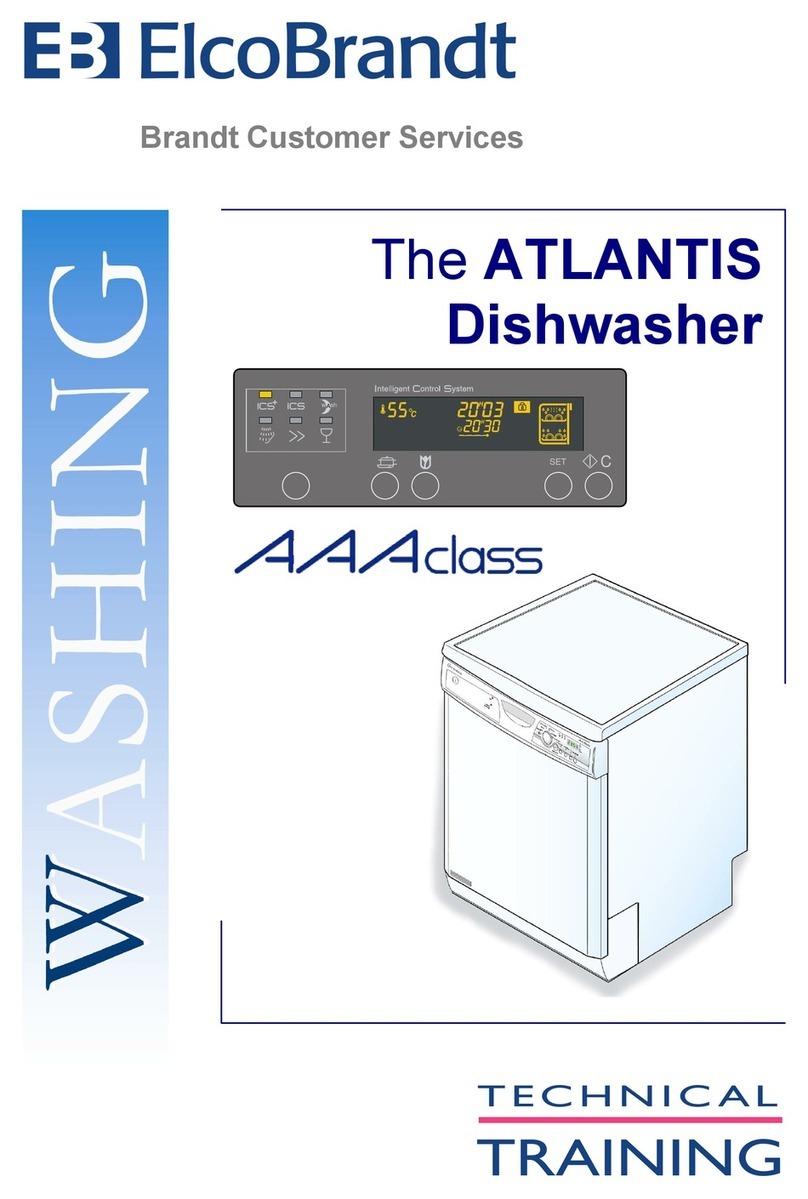Bellini BFDM146X Installation instructions

GSM Retail Australia Pty Ltd ABN: 53 007 582 475
For Warranty and technical queries: 1300 373 199 Aus Or 0508123108 NZ www.belliniappliances.com.au
Model: BFDM146X, BFDM146X-F – 60cm Full Integrated Dishwasher
V.4October 2019
INSTALLATION & OPERATION
INSTRUCTIONS
60cm Fully Integrated Dishwasher
Model No. BFDM146X
FINELINE NUMBER:0133505

GSM Retail Australia Pty Ltd ABN: 53 007 582 475
For Warranty and technical queries: 1300 373 199 Aus Or 0508123108 NZ www.belliniappliances.com.au
Model: BFDM146X, BFDM146X-F –60cm Full Integrated Dishwasher
Thank you
Thank you for choosing Bellini Appliances.
Bellini prides itself on ‘affordable living’
making sure there is no compromise in your
favourite room … The Kitchen
All Bellini appliances carry a 3-year In
Home warranty,
be sure to retain your installation and user
manual and
receipt.
For all warranty and technical queries,
please contact
1300 373 199

GSM Retail Australia Pty Ltd ABN: 53 007 582 475
For Warranty and technical queries: 1300 373 199 Aus Or 0508123108 NZ www.belliniappliances.com.au
Model: BFDM146X, BFDM146X-F –60cm Full Integrated Dishwasher
CONTENTS
USING YOUR DISHWASHER
Control Panel
Preparing and Loading Dishes
Function of the Rinse Aid and Detergent
Filling the Rinse Aid Reservoir
Filling the Detergent Dispenser
TECHNICAL INFORMATION
NOTE:
If you cannot solve the problems by yourself, please ask for help from a
professional technician.
The manufacturer, following a policy of constant development and
updating of the product, may make modifications without giving prior
notice.
If lost or out-of-date, you can receive a new user manual from the
manufacturer or responsible vendor.
ERROR CODES
PROGRAMMING THE DISHWASHER
Wash Cycle Table
Starting a Cycle Wash
Changing the program Mid-cycle forget to add
a dish?

SAFETY INFORMATION
WARNING
When using your dishwasher, follow the precautions listed below:
Installation and repair can only be carried out by a qualified technician
This appliance is intended to be used in household and similar applications
such as:
-staff kitchen areas in shops, offices and other working environments;
-farm houses;
-by clients in hotels, motels and other residential type environments;
-bed and breakfast type environments.
This appliance can be used by children aged from 8 years and above and
persons with reduced physical, sensory or mental capabilities or lack of
experience and knowledge if they have been given supervision or
instruction concerning use of the appliance in a safe way and understand
the hazards involved.
Children shall not play with the appliance. Cleaning and user maintenance
shall not be done by children without supervision. (For EN60335-1).
This appliance is not intended for use by persons (including children) with
reduced physical, sensory or mental capabilities, or lack of experience and
knowledge, unless they have been given supervision or instruction
concerning use of the appliance by a person responsible for their safety.
(For IEC60335-1) Packaging material could be dangerous for children!
This appliance is for indoor household use only. To protect against the risk
of electrical shock, do not immerse the unit, cord or plug in water or other
liquid.
Please unplug before cleaning and performing maintenance on the
appliance.
Use a soft cloth moistened with mild soap, and then use a dry cloth to wipe
it again.

Earthing Instructions
This appliance must be earthed. In the event of a malfunction or
breakdown, earthing will reduce the risk of an electric shock by providing
a path of least resistance of electric current. This appliance is equipped
with an earthing conductor plug.
The plug must be plugged into an appropriate outlet that is installed and
earthed in accordance with all local codes and ordinances.
Improper connection of the equipment-earthing conductor can result in
the risk of an electric shock.
Check with a qualified electrician or service representative if you are in
doubt whether the appliance is properly grounded.
Do not modify the plug provided with the appliance; If it does
not fit the outlet.
Have a proper outlet installed by a qualified electrician.
Do not abuse, sit on, or stand on the door or dish rack of the dishwasher.
Do not operate your dishwasher unless all enclosure panels are properly in
place.
Open the door very carefully if the dishwasher is operating, there is a
risk of water squirting out.
Do not place any heavy objects on or stand on the door when it is open.
The appliance could tip forward.
When loading items to be washed:
1) Locate sharp items so that they are not likely to damage the
door seal;
2) Warning: Knives and other utensils with sharp points must be
loaded in the basket with their points facing down or placed in a
horizontal position.
Some dishwasher detergents are strongly alkaline.
They can be extremely dangerous if swallowed. Avoid contact with the
skin and eyes and keep children away from the dishwasher when the
door is open.
Check that the detergent powder is empty after completion of the wash
cycle.
Do not wash plastic items unless they are marked “dishwasher safe” or the
equivalent.

For unmarked plastic items not so marked, check the manufacturer's
recommendations.
Use only detergent and rinse agents recommended for use in an automatic
dishwasher.
Never use soap, laundry detergent, or hand washing detergent in your
dishwasher.
The door should not be left open, since this could increase the risk of
tripping.
If the supply cord is damaged, it must be replaced by the manufacturer or
its service agent or a similarly qualified person in order to avoid a hazard.
During installation, the power supply must not be excessively or
dangerously bent or flattened.
Do not tamper with controls.
The appliance needs to be connected to the main water valve using new
hose sets. Old sets should not be reused.
To save energy, in standby mode, the appliance will switch off
automatically while there is no any operation in 30 minutes.
Disposal
For disposing of package and the appliance, please go to a
recycling center. Therefore, cut off the power supply cable and
make the door-closing device unusable.
Cardboard packaging is manufactured from recycled paper and
should be disposed in the waste paper collection for recycling.
By ensuring this product is disposed of correctly, you will help
prevent potential negative consequences for the environment
and human health, which could otherwise be caused by
inappropriate waste handling of this product.
For more detailed information about recycling of this product,
please contact your local city office and your household waste
disposal service.
DISPOSAL: Do not dispose this product as unsorted municipal
waste. Collection of such waste separately for special treatment
is necessary.

PRODUCT OVERVIEW
IMPORTANT:
To get the best performance from your dishwasher, read all operating instructions before using it for the first time.
NOTE:
Pictures are only for reference, different models may be different.
USING YOUR DISHWASHER
Before using your dishwasher:
1. Loading the basket
2. Fill the rinse aid dispenser (Please check the section 1 of PART Ⅱ:Special Version)
3. Fill in detergent (Please check the section 1 of PART Ⅱ:Special Version)

Basket Positioning
Adjusting the upper basket
Type 1:
The height of the upper basket can be easily adjusted to accommodate taller dishes in either the upper or
the lower basket.
To adjust the height of the upper rack, follow these steps:
Type 2:
the upper basket at the center of each
side until the basket locks into place in
the upper position. It is not necessary to
lift the adjuster handle.
adjust handles on each side to
release the basket and lower it to
the lower position.
Folding back the cup shelves
To make room for taller items in the upper basket, raise the cup rack upwards. You can then lean the tall glasses
against it. You can also remove it when it is not required for use.

Folding back the rack shelves
The spikes of the lower basket are used for holding plates and a platter.
They can be lowered to make more room for large items.
MAINTENANCE AND CLEANING
External Care
The door and the door seal
Clean the door seals regularly with a soft damp cloth to remove food deposits. When
the dishwasher is being loaded, food and drink residues may drip onto the sides of the
dishwasher door. These surfaces are outside the wash cabinet and are not accessed by
water from the spray arms. Any deposits should be wiped off before the door is
closed.
The control panel
If cleaning is required, the control panel should be wiped with a soft damp cloth only.
WARNING
To avoid penetration of water into the door lock and electrical components, do not use a spray
cleaner of any kind.
Never use abrasive cleaners or scouring pads on the outer surfaces because they may scratch the
finish. Some paper towels may also scratch or leave marks on the surface.
Internal Care
Filtering System
The filtering system in the base of the wash cabinet retains coarse debris from the
washing cycle. The collected coarse debris may cause the filters to clog. Check the
condition of the filters regularly and clean them if necessary under running water.
Follow the steps below to clean the filters in the wash cabinet.

NOTE:
Pictures are only for reference,
different models of the filtering
system and spray arms may be
different.
Do not over tighten the filters. Put the filters back in sequence securely, otherwise coarse debris could get into
the system and cause a blockage.
Never use the dishwasher without filters in place. Improper replacement of the filter may reduce the
performance level of the appliance and damage dishes and utensils.
Spray arms
It is necessary to clean the spray arms regularly for
hard water chemicals will clog the spray arm jets
and bearings
To clean the spray arms, follow the instructions;
It is necessary to clean the spray arms regularly for
hard water chemicals will clog the spray arm jets
and bearings
To clean the spray arms, follow the instructions
below:1
WARNING

Caring For the Dishwasher
Frost precaution
Please take frost protection measures on the dishwasher in winter. Every time after
washing cycles, please operate as follows:
1. Cut off the electrical power to the dishwasher at the supply source.
2. Turn off the water supply and disconnect the water inlet pipe from the water valve.
3. Drain the water from the inlet pipe and water valve. (Use a pan to gather the water)
4. Reconnect the water inlet pipe to the water valve.
5. Remove the filter at the bottom of the tub and use a sponge to soak up water in the
sump.
After every wash
After every wash, turn off the water supply to the appliance and leave the door slightly
open so that moisture and odors are not trapped inside.
Remove the plug
Before cleaning or performing maintenance, always remove the plug from the socket.
No solvents or abrasive cleaning
To clean the exterior and rubber parts of the dishwasher, do not use solvents or abrasive
cleaning products. Only use a cloth with warm soapy water.
To remove spots or stains from the surface of the interior, use a cloth dampened with
water and a little vinegar, or a cleaning product made specifically for dishwashers.
When not in use for a long time
It is recommend that you run a wash cycle with the dishwasher empty and then remove
the plug from the socket, turn off the water supply and leave the door of the appliance
slightly open. This will help the door seals to last longer and prevent odors from forming
within the appliance.
Moving the appliance
If the appliance must be moved, try to keep it in the vertical position. If necessary, it can
be positioned on its back.
Seals
One of the factors that cause odours to form in the dishwasher is food that remains
trapped in the seals. Periodic cleaning with a damp sponge will prevent this from
occurring.

INSTALLATION INSTRUCTION
The installation of the pipes and electrical equipment’s should be done by professionals.
About Power Connection
WARNING
For personal safety:
Do not use an extension cord or an adapter plug with this
appliance.
Do not, under any circumstances, cut or remove the earthing
connection from the power cord.
Electrical requirements
Please look at the rating label to know the rating voltage and connect the dishwasher to
the appropriate power supply. Use the required fuse 10A/13A/16A, time delay fuse or
circuit breaker recommended and provide separate circuit serving only this appliance.
Electrical connection
Ensure the voltage and frequency of the power being corresponds to those on the rating
plate. Only insert the plug into an electrical socket, which is earthed properly. If the
electrical socket to which the appliance must be connected is not appropriate for the
plug, replace the socket, rather than using an adaptors or the like as they could cause
overheating and burns.
Ensure that proper earthing exists before use

Water Supply And Drain
Cold water connection
Connect the cold water supply hose to
a threaded 3/4(inch) connector and
make sure that it is fastened tightly in
place.
If the water pipes are new or have not
been used for an extended period of
time, let the water run to make sure
that the water is clear. This precaution
is needed to avoid the risk of the
water inlet to be blocked and damage
the appliance.
ordinary supply hose
WARNING
A hose that attaches to a sink spray can burst if it is installed on the same
water line as the dishwasher. If your sink has one, it is recommended thet
the hose be disconnected and the hole plugged.

Connection of Drain Hoses
Insert the drain hose into a drainpipe with a minimum diameter of 4 cm, or let it run into
the sink, making sure to avoid bending or crimping it. The height of drainpipe must be
less than 1000mm. The free end of the hose must not be immersed in water to avoid
the back flow of it.
Please securely fix the drain hose in either position A or position B
How to drain excess water from hoses
If the sink is 1000 higher from the floor, the excess water in hoses cannot be drained
directly into the sink. It will be necessary to drain excess water from hoses into a bowl or
suitable container that is held outside and lower than the sink.
Water outlet
Connect the water drain hose. The drain hose must be correctly fitted to avoid water
leaks. Ensure that the water drain hose is not kinked or squashed.
Extension hose
If you need a drain hose extension, make sure to use a similar drain hose. It must be
no longer than 4 meters; otherwise, the cleaning effect of the dishwasher could be
reduced.
Syphon connection
The waste connection must be at a height less than 100 cm (maximum) from the
bottom of the dish. The water drain hose should be fixed.

Position the Appliance
Position the appliance in the desired location. The back should rest against the wall
behind it, and the sides, along the adjacent cabinets or walls. The dishwasher is
equipped with water supply and drain hoses that can be positioned to either the right or
the left sides to facilitate proper installation.
Levelling the appliance
Once the appliance is positioned for levelling, the height of the
dishwasher may be altered via adjustment of the screwing level of the
feet. In any case, the appliance should not be inclined more than 2°.
NOTE:
Only apply to the freestanding dishwasher.

Attention
After removing the worktop, the screws must be screwed again under the rear edge of
the top (b).
The height will then be reduced to 815 mm, as scheduled by the International
Regulations (ISO) and the dishwasher will fit perfectly under the kitchen-working top.
Built-In Installation (for the integrated model)
Step 1. Selecting the best location for the dishwasher
The installation position of dishwasher should be near the existing inlet and drain hoses and power cord.
Illustrations of cabinet dimensions and installation position of the dishwasher.
1. Less than 5 mm between the top of dishwasher and cabinet and the outer door aligned to cabinet.
2. If dishwasher is installed at the corner of the cabinet, there should be some space when the door
is opened.
NOTE: Depending on where your electrical outlet is, you may need to cut a hole in the opposite
cabinet side.
Step 2. Aesthetic panel's dimensions and installation
Fitting of the decorative cabinet panel to be conducted as per
instructions/illustrations as detailed below.

Full-integrated model
Install the metal hook hardware (Supplied) to the back of the decorative cabinet panel,
ensure that these align with the slots and mounting pads of the dishwasher door frame
as in Figure A
Position decorative cabinet panel to the dishwasher and ensure that it is fitted equal
distance from the adjoining cabinet doors.
When happy with the position of the panel, you can now permanently secure with 4
screws as shown in figure B.
First, remove the 4 shorter screws and replace with the longer screws (Supplied) that
ensures retention of decorative cabinet panel to dishwasher door.

Step 3. Tension adjustment of the door spring
1. The door springs are set at the factory to the proper tension for the outer door. If
decorative cabinet panels are installed, you will have to adjust the door spring tension.
Rotate the adjusting screw to drive the adjustor to strain or relax the steel cable.
2. Door spring tension is correct when the door remains horizontal in the fully opened
position, yet rises to a close with the slight lift of a finger.
Step 4. Dishwasher installation steps
1. Affix the condensation strip under the work surface of cabinet. Please ensure the condensation strip
is flush with edge of work surface.
2. Connect the inlet hose to the cold water supply.
3. Connect the drain hose.
4. Connect the power cord.
5. Place the dishwasher into position.
6. Level the dishwasher. The rear food can be adjusted from the front of the dishwasher by turning the
Philips screw in the middle of the base of dishwasher use a Philips screw. To adjust the front feet, use a
flat screwdriver and turn the front feet until the dishwasher is level.
7. Install the handle door to the outer door of the dishwasher.
8. Adjust the tension of the door springs by using an Allen key turning in a clockwise motion to tighten
the left and right door springs. Failure to do this could cause damage to your dishwasher.
9. The dishwasher must be secured in place. There are two ways to do this:
A. Normal work surface: Put the installation hook into the slot of the side plane and secure it to
the work surface with the wood screws.
B. Marble or granite work top: Fix the side with Screw.

Step 5. Levelling the dishwasher
Dishwasher must be level for proper dish rack operation and wash performance.
1. Place a spirit level on door and rack track inside the tub as shown to check
that the dishwasher is level.
2. Level the dishwasher by adjusting the three levelling legs individually.
3. When level the dishwasher, please pay attention not to let the dishwasher
tip over.
NOTE:
The maximum adjustment height of the feet is 50 mm.

TROUBLESHOOTING TIPS
Before Calling For Service
Reviewing the charts on the following pages may save you from calling for service.
Problem
Possible Causes
What To Do
Dishwasher doesn't
start
Fuse blown or the circuit break
tripped.
Replace fuse or reset circuit breaker. Remove any other
appliances sharing the same circuit with the
dishwasher.
Power supply is not turned on.
Make sure the dishwasher is turned on and the door is
closed securely. Make sure the power cord is properly
plugged into the wall socket.
Water pressure is low
Check that the water supply is connected properly
and the water is turned on.
Door of dishwasher not properly
closed.
Make sure to close the door properly and latch it.
Water not pumped
form dishwasher
Twisted or trapped drain hose.
Check the drain hose.
Filter clogged.
Check coarse the filter.
Kitchen sink clogged.
Check the kitchen sink to make sure it is draining well.
If the problem is the kitchen sink that is not draining,
you may need a plumber rather than a technician for
dishwashers.
Suds in the tub
Wrong detergent.
Use only the special dishwasher detergent to avoid
suds. If this occurs, open the dishwasher and let suds
evaporate. Add 1 gallon of cold water to the bottom of
the dishwasher. Close the dishwasher door, then select
any cycle. Initially, the dishwasher will drain out the
water. Open the door after draining stage is complete
and check if the suds have disappeared.
Repeat if necessary.
Spilled rinse-aid.
Always wipe up rinse-aid spills immediately.
Stained tub interior
Detergent with colourant may
have been used.
Make sure that the detergent has no colourant.
White film on
inside surface
Hard water minerals.
To clean the interior, use a damp sponge with
dishwasher detergent and wear rubber gloves.
Never use any other cleaner than dishwasher
detergent otherwise, it may cause foaming or
suds.
There are rust
stains on cutlery
The affected items are not corrosion
resistant.
The items should be corrosion resistant.
Knocking noise in the
dishwasher
A spray arm is knocking against an
item in a basket
Interrupt the program and rearrange the items,
which are obstructing the spray arm.
Table of contents
Other Bellini Dishwasher manuals
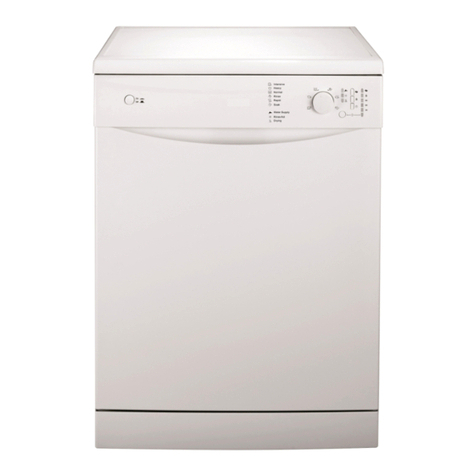
Bellini
Bellini BDW127W Installation instructions

Bellini
Bellini BDW6WP Installation instructions

Bellini
Bellini BDW86S -F User guide
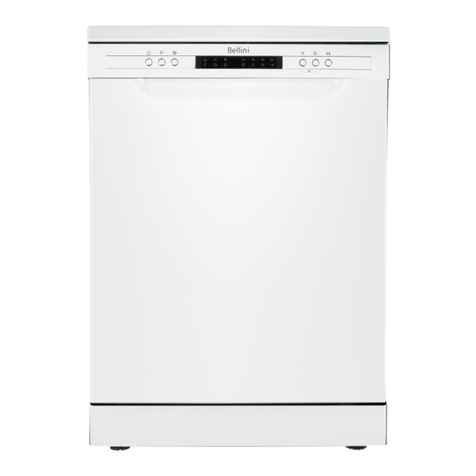
Bellini
Bellini BDWM46W Installation instructions

Bellini
Bellini BDDW605W User manual

Bellini
Bellini BDWM26W Installation instructions

Bellini
Bellini BDW96W-F Installation instructions

Bellini
Bellini BDW96W Installation instructions
